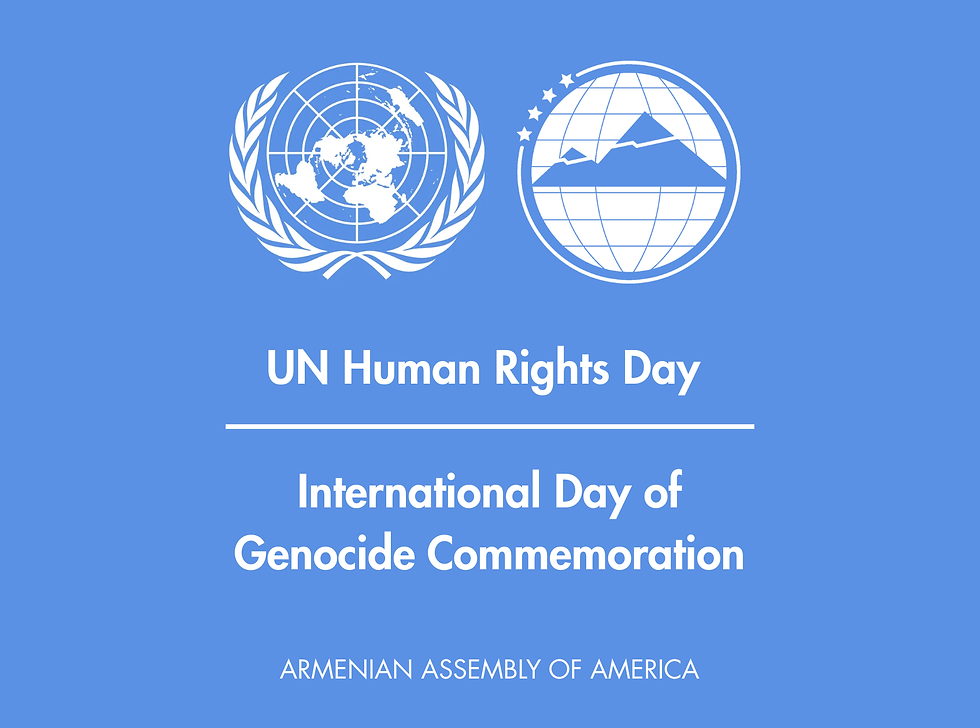Armenian National Institute Website Available in Spanish
- Armenian Assembly of America

- Apr 20, 2020
- 4 min read
Updated: Jun 11, 2021
Washington, D.C. – The Armenian National Institute (ANI) announced the launch of the Spanish version of its widely-consulted website on the Armenian Genocide. The creation of the Spanish ANI site follows upon the earlier successful launch of the Turkish language version of the site.

The ANI website contains extensive records on the history and affirmation of the Armenian Genocide when 1.5 million Armenian Christians fell victim to the Young Turk government policy of mass deportation and annihilation. The Spanish version reproduces ANI’s catalog of official documents from around the world. These records are posted in their original languages, many in PDF format, and can now be accessed in English, Turkish, and Spanish. The leading institutional website on the Armenian Genocide since its inception 23 years ago, the ANI website annually registers more than 7 million hits. Widely consulted by educators and students, the site is also a major source of information in preparation of April 24 commemorative activities utilized by journalists, government officials, and the public.
The ANI Spanish site reproduces many of the most popular sections of the main site: maps, photographs, FAQs, chronology, list of countries, and international affirmation records, including the milestone resolutions adopted by the United States House of Representatives and the United States Senate in October and December 2019 respectively.
Countries in the Spanish-speaking world were among some of the first to reaffirm the Armenian Genocide, with Uruguay leading the process as far back as 1965. Most South American countries, including Argentina, Bolivia, Chile, Paraguay, Venezuela, and Brazil recognize the Armenian Genocide. Portuguese-speaking Brazil was joined by Portugal itself whose parliament recognized the Armenian Genocide in April 2019.
“We feel privileged to bring the widely used ANI resource to the attention of the Spanish-speaking world, which has produced some of the greatest champions of human rights around the world” said ANI Board Chairman Van Z. Krikorian. “Raphael Lemkin, who coined the term ‘genocide’ in 1944, cited the Armenian experience as a definitional example. In supporting the 1948 United Nations Genocide Convention, the United States in 1951 did the same. In addition, the Armenian Genocide was cited as a precedent in the post-WWII Nuremberg trials. Campaigns to deny and rewrite the history of genocide and human rights violations have led to worse crimes and continue, even today.”
“The lessons those who remember the Armenian and other genocides try to teach relate directly to universal issues of basic human dignity. Genocides start with thoughts and words, build step by step, and culminate with mass scale violence, forced conversions, and similar atrocities. We stand with every person of good conscience to work against such man-made disasters and hope that instructional resources available through ANI can become additional tools for educating about this fundamental area of knowledge,” added Krikorian.
“The ANI Spanish site was created with the support and encouragement of several individuals,” added ANI Director Dr. Rouben Adalian. “I want to thank them for pulling together another chapter in the Institute’s ongoing efforts to educate the public about the Armenian Genocide. Our summer intern Serena Hajjar skillfully embarked on the project. Sonia Arakelian extended editorial support from Mexico City. Federico Gaitan Hairabedian, who heads the Buenos Aires, Argentina-based The Luisa Hairabedian Foundation, an organization dedicated to the cause of historical justice, and the team that he assembled, especially Garine Morcecian and Vilén Ter Gazarian, steered this phase of the project to completion,” added Dr. Adalian.
“Our longtime webmaster Mark Malkasian continues to guide ANI’s digital presence,” continued Dr. Adalian. “Above and beyond managing our Internet presence and seeing to it that the sites’ design makes the difficult subject of the Armenian Genocide easily accessible to the general public, especially to students and teachers, Malkasian continues to oversee making the site presentable in all platforms. As of late, he has overseen the upgrading of the ANI site and has made it even more mobile-friendly. Whichever their preferred platform, ANI visitors will be viewing a more streamlined website with easier access to content,” stated Dr. Adalian.
ANI maintains a broad range of online resources about the Armenian Genocide. The online museum is an interactive site allowing visitors to proceed at their own pace, and includes a very popular introductory video. Several digital exhibits released by ANI since the centennial of the Armenian Genocide cover many aspects of the experience of the Armenian people starting in 1915. The ANI digital exhibits are based on photographic collections from U.S. archival repositories and document the extensive humanitarian intervention of American volunteers, who arrived in Armenia and across the Middle East in the immediate aftermath of the genocide.
“I also want to thank The Luisa Hairabedian Foundation for collaborating with ANI, as well as recognize their many contributions for raising awareness about human rights and the recognition of the Armenian Genocide in Argentina. We appreciate their partnership, welcome their participation in bringing ANI resources to the attention of the Latin American public, and look forward to continuing our collaboration,” concluded Krikorian.
Founded in 1997, the Armenian National Institute (ANI) is a 501(c)(3) educational charity based in Washington, D.C., and is dedicated to the study, research, and affirmation of the Armenian Genocide.
###
NR# 2020-004


